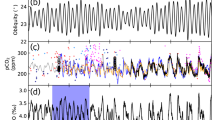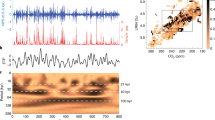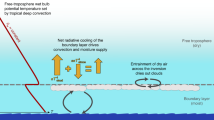Abstract
The Earth's climate over the past million years has been characterized by a succession of cold and warm periods, known as glacial–interglacial cycles, with periodicities corresponding to those of the Earth's main orbital parameters; precession (23 kyr), obliquity (41 kyr) and eccentricity (100 kyr). The astronomical theory of climate, in which the orbital variations are taken to drive the climate changes, has been very successful in explaining many features of the palaeoclimate records1. Nevertheless, the timing of the main glacial and interglacial periods remains puzzling in many respects2,3,4,5. In particular, the main glacial–interglacial switches occur approximately every 100 kyr, but the changes in insolation forcing are very small in this frequency band. Similarly, an especially warm interglacial episode, about 400,000 years ago7, occurred at a time when insolation variations were minimal. Here I propose that multiple equilibria in the climate system can provide a resolution of these problems within the framework of astronomical theory. I present two simple models that successfully simulate each glacial–interglacial cycle over the late Pleistocene epoch at the correct time and with approximately the correct amplitude. Moreover, in a simulation over the past 2 million years, the onset of the observed prominent ∼100-kyr cycles around 0.8 to 1 million years ago is correctly reproduced.
This is a preview of subscription content, access via your institution
Access options
Subscribe to this journal
Receive 51 print issues and online access
$199.00 per year
only $3.90 per issue
Buy this article
- Purchase on Springer Link
- Instant access to full article PDF
Prices may be subject to local taxes which are calculated during checkout




Similar content being viewed by others
References
Hays, J. D., Imbrie, J. & Shackleton, N. J. Variations in the earth's orbit: Pacemakers of the ice ages. Science 194, 1121–1132 (1976).
Imbrie, J.et al. On the structure and origin of major glaciation cycles: 1. Linear responses to Milankovitch Forcing. Paleoceanography 7, 701–738 (1992).
Muller, R. A. & MacDonald, G. J. Glacial cycles and orbital inclination. Nature 377, 107–108 (1995).
Imbrie, J. & Imbrie, J. Z. Modelling the climatic response to orbital variations. Science 207, 943–953 (1980).
Ghil, M. & Le Treut, H. Aclimate model with cryodynamics and geodynamics. J. Geophys. Res. 86, 5262–5270 (1981).
Saltzman, B., Hansen, A. R. & Maasch, K. A. The late Quaternary glaciations as the response of a three-component feedback system to Earth-orbital forcing. J. Atmos. Sci. 41, 3380–3389 (1984).
Howard, W. R. Awarm future in the past. Nature 388, 418–419 (1997).
Imbrie, J.et al. On the structure and origin of major glaciation cycles: 2. The 100,000-year cycle. Paleoceanography 8, 699–735 (1993).
Paillard, D. Modèles simplifiés pour l'étude de la variabilité de la circulation thermohaline au cours des cycles glaciaire-interglaciaire.Thesis, Univ. Paris-Sud (1995).
Berger, A. Long-term variations of daily insolation and Quaternary climatic change. J. Atmos. Sci. 35, 2362–2367 (1978).
Ruddiman, W. F., Raymo, M. E., Martinson, D. G., Clement, B. M. & Backman, J. Pleistocene evolution: northern hemisphere ice sheets and north atlantic ocean. Paleoceanography 4, 353–412 (1989).
Stommel, H. M. Thermohaline convection with two stable regimes of flow. Tellus 13, 224–230 (1961).
Bryan, F. High-latitude salinity effects and interhemispheric thermohaline circulations. Nature 323, 301–304 (1986).
Manabe, S. & Stouffer, R. J. Two stable equilibria of a coupled ocean-atmosphere model. J. Clim. 1, 841–866 (1988).
Rooth, C. Hydrology and ocean circulation. Prog. Oceanogr. 11, 131–149 (1982).
Thual, O. & McWilliams, J. C. The catastrophic structure of thermohaline convection in a two-dimensional fluid model and a comparison with low-order box model. Geophys. Astrophys. Fluid Dyn. 64, 67–95 (1992).
Jouzel, J.et al. Climatic interpretation of the recently extended Vostok ice records. Clim. Dyn. 12, 513–521 (1996).
Laskar, J. The chaotic motion of the solar system: A numerical estimate of the chaotic zones. Icarus 88, 266–291 (1990).
Raymo, M. The timing of major climate terminations. Paleoceanography 12, 577–585 (1997).
Rahmstorf, S. Bifurcations of the Atlantic thermohaline circulation in response to changes in the hydrological cycle. Nature 378, 145–149 (1995).
Manabe, S. & Stouffer, R. J. Century-scale effects of increased atmospheric CO2on the ocean-atmosphere system. Nature 364, 215–218 (1993).
Cortijo, E.et al. Eemian cooling in the Norwegian Sea and North Atlantic ocean preceding continental ice-sheet growth. Nature 372, 446–449 (1994).
Dansgaard, W.et al. The abrupt termination ofthe Younger Dryas climate event. Nature 339, 532–534 (1989).
Bassinot, F. C.et al. The astronomical theory of climate and the age of the Brunhes-Matuyama magnetic reversal. Earth Planet. Sci. Lett. 126, 91–108 (1994).
Tiedemann, R.et al. Astronomic timescale for the Pliocene Atlantic δ18O and dust flux records of Ocean Drilling Program site 659. Paleoceanography 9, 619–638 (1994).
Adkins, J. F.et al. Variability of the North Atlantic thermohaline circulation during the last interglacial period. Nature 390, 154–156 (1997).
Acknowledgements
We thank S. Clemens and to M. Raymo for encouragement and comments on this Letter.
Author information
Authors and Affiliations
Corresponding author
Rights and permissions
About this article
Cite this article
Paillard, D. The timing of Pleistocene glaciations from a simple multiple-state climate model. Nature 391, 378–381 (1998). https://doi.org/10.1038/34891
Received:
Accepted:
Issue Date:
DOI: https://doi.org/10.1038/34891
This article is cited by
-
Exponential feedback effects in a parametric resonance climate model
Scientific Reports (2023)
-
A gradual change is more likely to have caused the Mid-Pleistocene Transition than an abrupt event
Communications Earth & Environment (2023)
-
Brief interviews with hideous stone: a glimpse into the butchery site of Isernia La Pineta — a combined technological and use-wear approach on the lithic tools to evaluate the function of a Lower Palaeolithic context
Archaeological and Anthropological Sciences (2023)
-
The Mid-Pleistocene Transition: a delayed response to an increasing positive feedback?
Climate Dynamics (2023)
-
Pleistocene allopatric differentiation followed by recent range expansion explains the distribution and molecular diversity of two congeneric crustacean species in the Palaearctic
Scientific Reports (2021)
Comments
By submitting a comment you agree to abide by our Terms and Community Guidelines. If you find something abusive or that does not comply with our terms or guidelines please flag it as inappropriate.



